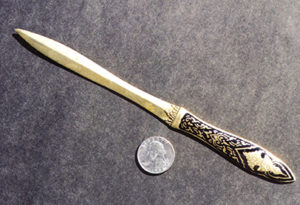 By Barry Krause
By Barry Krause Letter openers have been known since the 18th century, but became a popular tool after envelopes were mass produced starting in the mid-19th century when postage rates were reduced for letters mailed inside envelopes.
Before that time, almost all letters were simply folded to leave a blank portion where the address was written and postmarks applied, and the paper’s edges sealed with melted wax. The invention of practical envelopes coincided with the worldwide reduction in postage fees for mailing letters enclosed in envelopes, increasing demand for letter openers by business firms, government offices and private citizens.
The first successful machine for making envelopes was patented in 1849 by Jesse Park and Cornelius Watson of New York City. In 1853, Dr. Russell Hawes of Worcester, Mass. patented an improved version of an envelope folding machine that enabled three girl employees to make 25,000 finished envelopes in a ten hour work day, according to “An Early History of the Envelope” by the u.s. Envelope Company.
If you only received an occasional letter envelope in the mail, a letter opener may have been an unnecessary luxury. But, with postage rates dropping in most countries from the mid to late-19th century, plus with increasing incomes of the working classes of people, the letter openers were useful to almost everyone, and many people collected more letter openers than they needed.
“These knife-like collectibles are also handy little desk accessories. Constructed of almost any type of material, early manufacturers found them to be wonderful tools for advertising,” explains the 4th edition of “Warman’s Flea Market Price Guide.”
The wealthy consumers in the 19th century could afford custom-made letter openers of ivory or silver, while the less rich made do with base metal openers, but often with interesting figural handles nevertheless. “In the late 19th century, the letter opener was popular as an advertising giveaway and many were made of metal or celluloid,” says the latest edition of “Kovels’ Antiques & Collectibles Price List.”
While common “dime store” letter openers of a 100 years ago or so can still be bought today for modest prices, other scarce examples can bring astonishing prices in the current collectibles market.
A Faberge letter opener of 9 3/4 inches long, with a jade blade and gold handle, ruby insets, is worth $1,950 today, and an 1897 Sterling silver letter opener issued to honor the 200th anniversary of the original “Sleepy Hollow Bridge” is now valued at a remarkable $2,450, according to Kovels.
Hand-made, one-of-a-kind letter openers have much charm and come in all price ranges to suit any collector’s budget. Fold art letter openers of the “Arts and crafts” movement are especially nice, but we must separate sentimental appeal from cash value.
My dad made a letter opener by hand from a piece of airplane window glass when he was a soldier in World War II, as a gift to my mom who later married him. This letter opener is a true specimen of World War II “trench art,” of moderate value to a stranger, but priceless to my family because it is an irreplaceable personal keepsake.
The 20th century’s advertising letter openers are for sale in just about every antique mall that I visit. A nice plastic letter opener with the “Fuller Brush Man” design is worth $8.00, and a late 1930s “Indianapb1is Motor Speedway” themed letter opener, 6 1/4 inches long, with copper luster over white metal, but with a medallion near the top with a race car image, is $40, according to current retail prices in Warman’s.
Bronze and brass were common metals for letter openers commercially manufactured. Resist the temptation to polish them to make them “shine like new.” Serious collectors appreciate the naturally aged patina on untouched old bronze and brassware.
Some collectors specialize in letter openers from their favorite tourist site, such as Niagara Falls, Washington, D.C. or National Parks. Modern versions can still be bought in tourist gift shops, a cheap way to begin a collection of them at low cost.
A bronze letter opener from Miami Beach, with an alligator handle, sold to tourists there in the 1930s, is valued at only $15, and a brass letter opener from Butte, Montana, 9 1/4 inches long, with an embossed mining scene, can be had for $30 today, according to Kovels.
Letter openers are a collectible field that is neglected by many collectors. That means there are great buys waiting to be discovered by those who know what to look for.
“Local” business advertising openers are most expensive in antique shops in the towns where the businesses were located, and least expensive in antique shops in faraway states, as a general rule from my experience in browsing in shops allover the country.
Some exceptions would be “World’s Fair” letter openers which can bring top dollar wherever they are offered for sale due to the widespread collecting of World’s Fair memorabilia.
Original Art Nouveau and Art Deco letter openers can be worth hundreds of dollars each if of fine workmanship in such materials as celluloid, tortoiseshell, platinum, ivory, silver or gold. Watch out for modern replicas worth only their precious metal value if any.
Picture:
This eight-inch letter opener is made of gold-tone base metal, with black enamel to highlight the decorations on its handle. It has pleasant proportions, comfortable to grip, and balances perfectly at the point where its handle meets the blade. Recently acquired by the author as a gift, but with more sentimental value than cash worth, but still useful to open letters! Shown with a quarter dollar coin to indicate dimensions.















Follow Us